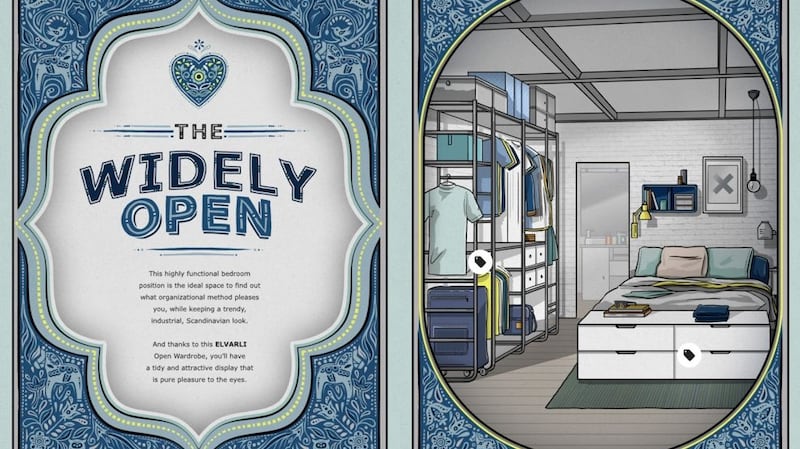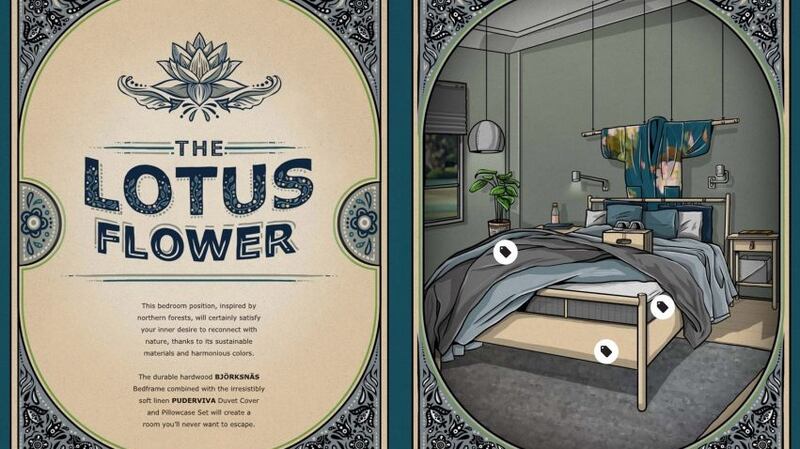Property was once declared the new porn, but that was in the heady days of the last boom before the market collapsed. Now, it seems, interiors are the new pleasure zone, at least in the world of Ikea.
The company with a gift for sexing up its attainable style – how do they manage to make wire shelving desirable? – has now come up with a . . . new Kama Sutra.
Ah yes, we’ve heard all about the free and easy ways of those tall, blond sexually open Swedes with their Viking good looks coming here (and everywhere else) and turning design sensibilities upside down. Now they’re targeting the world’s bedrooms with their Kama Sutra.
The title comes, of course, complete with a Swedish superdot – the little ring accent thingey – over the A of Kåma, giving it an air of Scandinavian authenticity, and it promises to help you to “master the art of loving your bedroom” by exploring “positions” from classic to modern.

Playing playfully on the ancient Indian Sanskrit text on sexuality, eroticism and emotional fulfilment, the Ikea Kåma Sutra declares everyone should have “a bedroom space that satisfies their everyday needs on both a physical and spiritual level”.
Asking readers if they are satisfied, or have “grown bored or tired with the same old bedroom positions? Do you yearn for more?”, Ikea gets frisky with a short video of an unidentified (headless, wedding-ringed) man lovingly fondling the pages of an Ikea Kåma Sutra book (in reality the book is digital only).
“If you want more, there’s no shame in that. Ikea has spent years studying life at home to help every bedroom lover reach the highest level of fulfilment.”
The handy (snigger) manual offers a series of 20 “bedroom positions”, or double entendre-laden styles and layouts, from classic to minimal: the lotus flower, the beautiful behind, the widely open (for those who “like to show it all” with open wardrobes and shelving), a glowing boudoir, the seated desire (a couch at the end of the bed), the climber (for those who “are not afraid to be on top” – yes, that’ll be a loft bed with sofa below), and doggy style (for those inclined to share their bedroom, but presumably not their sex life, with a mongrel).
It has drawings of the design ideas, which you can click to, oooh! reveal details of the products in the drawings, or labels for instant – ahhhh! purchasing satisfaction



Oooh-er missus, we’ll faint with all this smutty subtext and nudge-nudge naughtiness.
It has drawings of the design ideas, which you can click to, oooh! reveal details of the products in the drawings, or labels for instant – ahhhh! purchasing satisfaction.
Those products – from bedding and mirrors to bedframes and chests (fnarr, fnarr) – appear to be from Ikea’s regular range, but packaged in saucily named combos for maximum marketing fun, proving what we know well: sex sells. (And “sex” with a sense of humour sells even better.)
Ikea tells us “whether you’re restless or yearning for more, this book has a position for you” and for fear readers might be fainting with fright, it consoles “And by ‘position’ we mean bedroom solution. Wouldn’t want you getting the wrong idea.”
This is having a bit of fun with the dark art of marketing, though you could argue it’s a bit of a tease as the promise is not borne out in actuality by erotically-inspired design.
For that you need to look elsewhere, for example at Miguel Bolivar, who is having a crack at designing sex. In his book The Archisutra: The Handbook's Final Chapter, the London-based architect says that in an age of ubiquitous design, why shouldn't sex be designed as well?
The London-based architect’s design manual, in English and published by Walther König last month, offers “the necessary data” for a selection of sex positions, using annotated scale drawings and succinct, explicit descriptions.
It’s not a joke (and is not designed to sell products, thankfully), but is witty in its descriptions of its humorously-named, architecture-inspired sex positions: the Truss me, the Eames it in, and the Get an Eiffel. The book description says: “The bodies in the book arch, vault and cantilever over drafting tables, Eames lounges and Barcelona chairs, connecting their configurations to the designs that inspired them. The Archisutra imagines the sexual spirit of classical, neoclassical, brutalist and other styles of architecture.”
The ultimate tease in the erotic design frontier is that Ikea's Kåma Sutra isn't to be found on its Irish site; it's only on <a href="https://www.ikea.com/ms/en_US/kama-sutra/" target="_blank">Ikea.com</a>
Bolivar, realising sexuality isn't a factor in design, has said that wondering "how often sex is considered when an architect designs a building" inspired him "to write a tongue-in-cheek book highlighting this". So he came up with a guide to 50 sex positions to "redesign" a sex life. He chose good company, saying it follows on from the work of Vitruvius, da Vinci and Le Corbusier, pushing the idea that buildings should be designed around human life.
Amusingly, the book also documents the “sustainability” of each position – or how long each position can be maintained over time.
The ultimate tease in the erotic design frontier is that Ikea’s Kåma Sutra isn’t to be found on its Irish site; it’s only on Ikea.com. Get down off that high horse and resist the urge to assume this is a new age of censorship for the formerly repressed Irish; it’s because the campaign is from Ikea’s US marketing zone. Yep, a product not of open-minded Scandinavians but of the land of prudish born-agains and coy euphemism.
But come on (so to speak), if they had thought to include Irish sexuality, they could have had a Kama Sutra full of furniture we could shift, with rooms for riding, and beds out of which we would not kick someone for eating Tayto.






